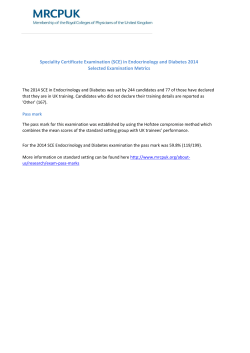
First Presentation of Diabetes as Diabetic
CASE STUDIES First Presentation of Diabetes as Diabetic Ketoacidosis in a Case of Friedreich’s Ataxia Partha Pratim Chakraborty, Sayantan Ray, Rana Bhattacharjee, Sujoy Ghosh, Pradip Mukhopadhyay, Satinath Mukhopadhyay, and Subhankar Chowdhury I ndividuals with Friedreich’s ataxia (FA) have an increased risk of developing diabetes. However, the type, onset, and course of diabetes in people with FA are not well characterized. In FA-associated diabetes, both insulin deficiency and insulin resistance have been reported. The presentation and clinical features of diabetes that occur in patients with FA cannot be distinguished from those occurring in other types of young-onset diabetes patients. Diabetes in FA is apparently always discovered long after the onset of neurological disability. However, the diabetes onset may be acute, with patients requiring insulin at diagnosis for effective control of blood glucose. We recently identified one such case of FA and diabetes in which the first presentation of diabetes was with diabetic ketoacidosis (DKA). More intriguing was that the FA was diagnosed after the patient was admitted with diabetes, and the diabetes was strictly insulin-dependent and ketosis-prone. Moreover, the immune markers typical of type 1 diabetes were absent. Department of Endocrinology, Institute of Post Graduate Medical Education & Research and SSKM Hospital, Kolkata, West Bengal, India Corresponding author: Sayantan Ray, sayantan.ray30@gmail.com DOI: 10.2337/diaclin.33.2.84 ©2015 by the American Diabetes Association. Readers may use this article as long as the work is properly cited, the use is educational and not for profit, and the work is not altered. See http:// creativecommons.org/licenses/by-nc-nd/3.0 for details. Presentation A 14-year-old boy from a poor socioeconomic background presented to us in a progressively increasing disoriented and confused state after 2 days of emesis. There was no history of diarrhea, abdominal pain, convulsions, loss of consciousness, or relevant drug/substance abuse. On inquiry, a month-long history of osmotic symptoms was evident. There was no family history of diabetes in any first- or second-degree relatives. The patient’s vitals were as follows: respiratory frequency 30 breaths/min, heart rate 120 bpm, blood pressure 110/60 mmHg, and temperature 101°F. Initial laboratory results included the following: blood glucose 609 mg/dL, arterial blood gas pH 7.1, serum bicarbonate 9.5 mEq/L, serum ketones 6 mmol/L, and urinary ketones strongly positive. An electrocardiogram showed Q waves in infero-lateral leads. A working diagnosis of DKA was made, and he was treated with intravenous fluids, insulin, potassium, and antibiotics. Subsequent investigations revealed an A1C of 10.5% (by NGSP allied assay). Pancreatic autoantibodies (anti-GAD65 and anti-IA2 antibodies) were negative. During the course of hospitalization after resolution of DKA, the patient was noted to have difficulties with walking and standing and slurring of speech. A detailed neurological examination revealed a highly ataxic gait, hypoactive knee and ankle jerks, bilateral extensor plantar responses, and impairment of position and vibratory senses. Dysmetria and intentional tremors were also present. On inquiry, we found that a year before admission, the patient had seen a primary care physician for progressive ataxia, and a magnetic resonance imaging scan of brain done at that time was reportedly normal. A nerve conduction velocity study of both lower limbs suggested axonal 84CLINICAL.DIABETESJOURNALS.ORG chakraborty et al. type sensorimotor neuropathy, and a diagnosis of hereditary sensory neuropathy was considered. During this hospitalization, the patient underwent a screening echocardiogram for persistent Q waves, which revealed concentric, symmetric hypertrophy of the left ventricle with asymmetric septal hyperthrophy. With a presumptive diagnosis of FA, genetic analysis was performed. It showed peaks beyond the threshold level (~250 base pairs), indicating the presence of an expanded allele. A short polymerase chain reaction suggested the presence of homozygous alleles in the FRDA gene. He was diagnosed with FA-associated insulin-dependent diabetes and cardiomyopathy and discharged with a split-mixed insulin regimen of NPH and rapid-acting insulins. After 2 months of satisfactory glycemic control, his postmeal serum C-peptide level was 2.1 ng/mL (cutoff 1.8 ng/mL). Questions 1. 2. 3. 4. 5. Are any genetic syndromes related to diabetes? What are the characteristics of FA-associated diabetes? Do mild abnormalities of glucose tolerance in patients with FA warrant close monitoring? How does insulin resistance develop in FA? Could an insulin sensitizer be useful in FA-associated diabetes? Commentary FA is an autosomal recessive neurodegenerative disease caused by a mutation in the FRDA gene, resulting in decreased expression of frataxin, a mitochondrial protein involved in iron metabolism. It has been known for more than a century that individuals with FA have an increased risk of developing diabetes. About 10% of patients with FA develop diabetes, and about 20% have carbohydrate intolerance (1,2). The mechanisms are complex, with both β-cell dysfunction and peripheral insulin resistance, possibly resembling other mi- tochondrial disorders associated with diabetes (3). Most cases of FA are caused by expansion of a GAA trinucleotide repeat in the intron 1 of the frataxin gene (4). Diabetes is correlated with the size of the GAA trinucleotide expansion in the FRDA gene in some studies (5,6). Contrary to cardiomyopathy, diabetes has never been reported as the presenting symptom of FA. Patients with FA and diabetes usually have a longer duration of neurological complaints before development of hyperglycemia and a younger age at onset of diabetes (5). In FA, both insulin deficiency and insulin resistance have been reported. Several case reports have described DKA, the hallmark of absolute insulin deficiency (7,8). The patient we described also manifested diabetes as DKA. This insulin-dependent ketosis-prone diabetes is suggested to be the result of nonautoimmune destruction of insulin-producing β-cells (9). There were no positive immune parameters typical of type 1 diabetes at the clinical onset of diabetes in our case. Insulin resistance has also been demonstrated at the whole body and cellular level in these patients (10,11). In a recently published study (12), FA patients had increased body fat content and consequent insulin resistance. Importantly, this resistance was not compensated for by increased insulin secretion, indicating pancreatic β-cell failure. β-Cell dysfunction and death are prerequisites for development of diabetes. In FA, mitochondrial dysfunction in liver, fat, and muscle, either directly or indirectly, leads to the development of insulin resistance. This is a source of metabolic stress for the pancreatic β-cells. A growing body of evidence suggests that β-cell dysfunction in FA is the consequence of mitochondrial defects and an increased sensitivity to metabolic and endoplasmic reticulum (ER) stress–induced apoptosis (12,13). Because FA patients are both insulin deficient and insulin resistant, therapeutic interventions address- ing both these issues are required. Metformin or thiazolidinedione treatment may otherwise improve insulin sensitivity but should probably be used with caution in mitochondrial diseases such as FA. Exogenous insulin administration is often required in FA patients, as occurred in this case. The average insulin requirement was also relatively higher in this case (1 unit/kg body weight). The potential β-cell– and neuroprotective properties of GLP-1 raise the question of whether incretin analogs should be considered in FA (12,14). A better understanding of the molecular mechanisms mediating β-cell demise in FA will pave the way for new therapeutic approaches. Clinical Pearls • FA is one of the genetic syndromes sometimes associated with diabetes. • Diabetes is usually detected long after the onset of neurological disability, but the onset can be simultaneous and is often acute, with patients requiring insulin at diagnosis. • Patients with FA and mild abnormalities of glucose tolerance should be regularly reassessed because rapid progression from chemical to clinical diabetes commonly occurs, and untreated patients may end up in ketosis. • In FA patients, a loss of islet cells causes diabetes, but the markers of autoimmunity associated with type 1 diabetes are not observed. • β-Cell dysfunction in FA is the consequence of mitochondrial defects and an increased sensitivity to metabolic and ER stress–induced apoptosis. Duality of Interest No potential conflicts of interest relevant to this article were reported. References 1. Melo M, Fagulha A, Barros L, Guimaraes J, Carrilho F, Carvalheiro M. Friedreich ataxia and diabetes mellitus-family study. Acta Med Port 2005;18:479–483 V O L U M E 3 3 , N U M B E R 2 , S P R I N G 2 0 1 5 85 CASE STUDIES 2. Hewer RL, Robinson N. Diabetes mellitus in Friedreich’s ataxia. J Neurol Neurosurg Psychiatry 1968;31:226–231 3. Chamberlain S, Shaw J, Rowland A, et al. Mapping of mutation causing Friedreich’s ataxia to human chromosome 9. Nature 1988;334:248–250 4. Campuzano V, Montermini L, Molto MD, et al. Friedreich’s ataxia: autosomal recessive disease caused by an intronic GAA triplet repeat expansion. Science 1996;271:1423–1427 5. Delatycki MB, Paris DB, Gardner RJ, et al. Clinical and genetic study of Friedreich ataxia in an Australian population. Am J Med Genet 1999;87:168–174 6. Filla A, De Michele G, Cavalcanti F, et al. The relationship between trinucleotide (GAA) repeat length and clinical features in Friedreich ataxia. Am J Hum Genet 1996;59:554–560 7. Bird TD, Turner JL, Sumi SM, Bierman EL. Abnormal function of endocrine pancreas and anterior pituitary in Friedreich’s ataxia: studies in a family. Ann Intern Med 1978;88;478–481 8. Gucev Z, Tasic V, Jancevska A, et al. Friedreich ataxia (FA) associated with diabetes mellitus type 1 and hyperthrophic cardiomyopathy. Bosn J Basic Med Sci 2009;9:107–110 9. Schoenle EJ, Boltshauser EJ, Baekkeskov S, Landin Olsson M, Torresani T, von Felten A. Preclinical and manifest diabetes mellitus in young patients with Friedreich’s ataxia: no evidence of immune process behind the islet cell destruction. Diabetologia 1989;32:378–381 10. Khan RJ, Andermann E, Fantus IG. Glucose intolerance in Friedreich’s ataxia: association with insulin resistance and decreased insulin binding. Metabolism 1986;35:1017–1023 11. Coppola G, Marmolino D, Lu D, et al. Functional genomic analysis of frataxin deficiency reveals tissue-specific alterations and identifies the PPARγ pathway as a therapeutic target in Friedreich’s ataxia. Hum Mol Genet 2009;18:2452–2461 12. Cnop M, Igoillo-Esteve M, Rai M, et al. Central role and mechanisms of β-cell dysfunction and death in Friedreich ataxia associated diabetes. Ann Neurol 2012;72:971–982 13. Koeppen AH. Friedreich’s ataxia: pathology, pathogenesis, and molecular genetics. J Neurol Sci 2011;303:1–12 14. Holst JJ, Burcelin R, Nathanson E. Neuroprotective properties of GLP-1: theoretical and practical applications. Curr Med Res Opin 2011;27:547–558 86CLINICAL.DIABETESJOURNALS.ORG
© Copyright 2025









